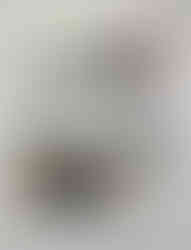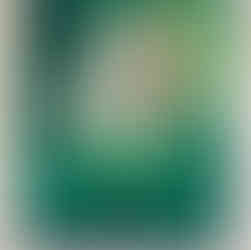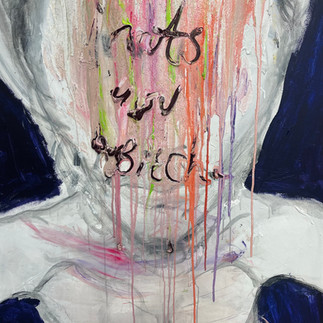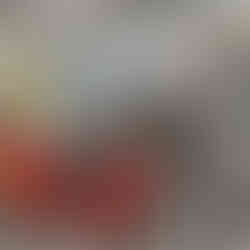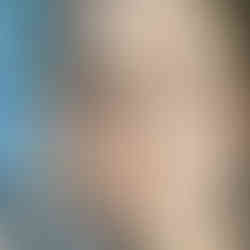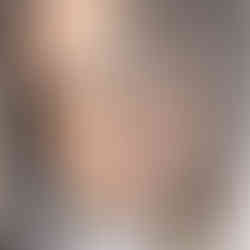
20 Oct 2024
With blurry lines, a love of family history and Indian pop-culture; unapologetic multi-faceted South Asian artist tells about his practice and life.
Umar Ahmed is a dear friend of the Home on Me Collective, travelling long distances to come to the ‘Our Stories’ opening, coming to our meetups, sporting a ‘Home on Me’ tote, and sharing our content online.
The youngest artist we’ve interviewed, a first year student at the Slade School of 19 years old at the time of interview, his ideas and perspectives are rich, unapologetic and evolving into the beautiful manifestations that are his works. Through his work drawing from his upbringing among the South Asian community of Leicester, his love of Bollywood (Kal Ho Na Ho inspirations anyone?) and his family history.
He creates unique pieces with various ideas and playful lines. Umar explores his identity through numerous photographs and self-portraits, which he develops upon through painting. Particularly polaroids, which he describes as true essence of a moment, place or sentiment.
Umar is steadfast in the belief that young South Asians can be who they wish, and do not have to be one thing. He has origins in India. But he also is a third generation immigrant who consumes various cultures and visual forms on a daily basis. Now living in London, his cultural reach has further expanded.
He is clearly a creature of the sensorial, engaging with the world around him, noticing both the big and small. The first line in our transcription, in fact was:
Umar: ‘My biggest advice is just to smell nice.’
We can testify he does. He then went on to describe inspirations.
Umar: I like having things around my Nani's [maternal grandmother] suitcase.

Zehra: It's such a stereotypical Indian suitcase to have with the flowers.
Umar: It's almost like holding hands with history as well, because my grandma came with it from India to Leicester, and then I came from Leicester to London.
Zehra: You're kind of just progressing with your family as you're taking a little bit of them. So tell me, what's the medium you work with most of the time?
Umar: Mostly oil paint. I just started using water. I don't think I know the proper way of using a brush and all that stuff. I don't get in a rut about it. I get some paint on the canvas and see what happens. I'm still learning how to use oil paint for God's sake. I still get my brushes all dried up. And that's okay because every day is a learning curve. And I think with a lot of the work I made, how it's produced is actually making me completely vulnerable and open. The process is so important.
Zehra: I do think art is instinctive at the end of the day. And I think a lot of people dwell too much on the technical aspects of it. And although those are extremely important, what is important is what comes from within. And when I looked at your work. I really liked your sofa piece. And I like the kind of muddiness of the painting. The lines are not that defined. It kind of makes you feel a little like it's a real thing. But it almost has a fantasy dream-like element about it.
Umar: The sofa piece was like this idea of grief, and I actually placed a figure on the sofa.
Zehra: I saw, and then you covered it up.

Pointing to another work Zehra likes, Umar explains:

Umar: That's my aunt on her wedding day. I was having a conversation with my sister over tea, chai, just talking about the population in Leicester and especially the South Asian community, so many women just popping out babies. I was like, oh, you know, what gets people like, going and having sex but with something in the chai.

Umar’s playfulness and hints of magic, exploring the sensual, makes consuming his work lots of fun. He goes on to explore this more when speaking about colour.
Umar: Colour is something I'm starting to use more in my work.
Zehra: I've always struggled to use a lot of colour in my work, because I think that immediately makes the work look childish or tacky. I feel like it's an Indian thing where, if you wore too much colour, you immediately were considered tacky. Even though India is so big on colour.
Umar: We need to be, like, breaking these stereotypes, destigmatizing. You don't have to be one or the other. I think there's so much room for change, especially in the art world. So it's funny that being in Leicester wanted to escape my culture, and coming to London, I want to celebrate it.
There is a lot of exploration of internalised prejudices and racism stemming from colonial cruelties inflicted upon us, that we had to shed part of ourselves to become ‘proper’, and these have persisted. To be a South Asian creative in the modern era is to navigate what is what. It is undoubtedly a challenge.
Umar: This painting here, 'Weird Star' , is a memory from primary school. I was always really good, and I wish I was a bit more rebellious. Even in secondary school, I was way too quiet, and I always got the star stickers, and I wore them on my clothes. I feel like I'm trying to twist things up even the littlest things can, bring back memories.

Zehra: I really like it. You know, self portraiture is like a really good way of seeing yourself in a way that you probably haven't seen yourself before. Sometimes it's difficult to know who you are.
Umar: It's like getting into yourself. And this image actually stemmed into me doing studies of Tiger faces.
Zehra: If you have to be an animal?
Umar: A tiger.
Zehra: I like that. You put the glitter and the eyes, yeah, and the fangs, that's really nice. So it seems you typography a lot of shop signs and slogans.

Umar: Being on the bus the scene just going on in my head, I become the main character with the soundtrack of Indian music. Shop windows displays. My family owns a shoe shop. I used to help my mom in the shop displays, like the coloured scarves together. And also, I think another thing about myself, my work, people say it's cliché, but a lot of it is quite intense. There's a lot going on in one artwork and the songs I can talk about. But it's like, how much do I say? How much do I give?
Zehra: Do you feel a little bit overstimulated or intimidated by the art scene in London?
Umar: Sometimes. Yeah, and if I'm being really honest with you, I've not had a great experience. Sometimes I go in to see shows and openings, and I'm made to feel a bit alienated or separated. And it shouldn't happen. It really shouldn't, like, be targeted or pushed aside because of the colour of my skin or my accent? But here I am.
Zehra: Here you are. People at the top are too busy sitting in their high towers to really understand what's happening on the ground. Which is one of the biggest problems, they're not even considering the artists that are actually so talented, but they just aren't seen or known because they're at the bottom. And why would they look down when they have all these other options in front of them? But on the other side of things do you think London helps you? The environment, the ambience, and just walking around and seeing all these different people being exactly who they want to be?
Umar: It kind of gives you the confidence to own it. And I think doing art makes you learn more about yourself. You're not trying to fit in or be a certain way.
Zehra: It's a very self reflective process. It's kind of like a journal entry. Who's your favourite artist at the moment?
Umar: Biggest inspiration, my mom, dad and my grandma. Artists, there's tons… But I'd say, from very early on, Tracy Emin. Because her work was autobiographical. When I realised everything came from her personal life, inside of her, a soulful woman. It really inspired me to say, ‘actually, I can share my own experience’.
Zehra: You have to be really, really brave in order to do something like that.
Umar: And Chila Kumari. She did that public installation at Tate Britain. Love her use of colour.
Zehra: Where do you see yourself in ten years?
Umar: Hopefully still painting, giving back to like communities. I want to work with charities. I want to be able to help people. And hopefully having a show or something, I don't know, uncertain. I love dance too.
Zehra: Anything you'd like to tell younger artists?
Umar: I mean I'm pretty young myself. But I’d say just be yourself. If you're struggling with something, speak out about it. Never suffer in silence. Don’t work to prove to others, Prove to yourself. That’s the main thing.
Umar’s deep love for his family and wider heritage was beautiful in its nuance. Throughout the interview, we noticed love for culture does not connote ignoring the parts of his community he feels ought to improve. He told us that happiness is a choice. And it seems he is indeed making this choice everyday, even when it might involve some overcoming.
Thank you for reading about this lovely thought-provoking artist. You can follow his work @umarahmedstudio on instagram.
The works below are available for purchase through Home on Me, which you can find on our store page or you can DM/Email us. They range from £150 to £2,750.








